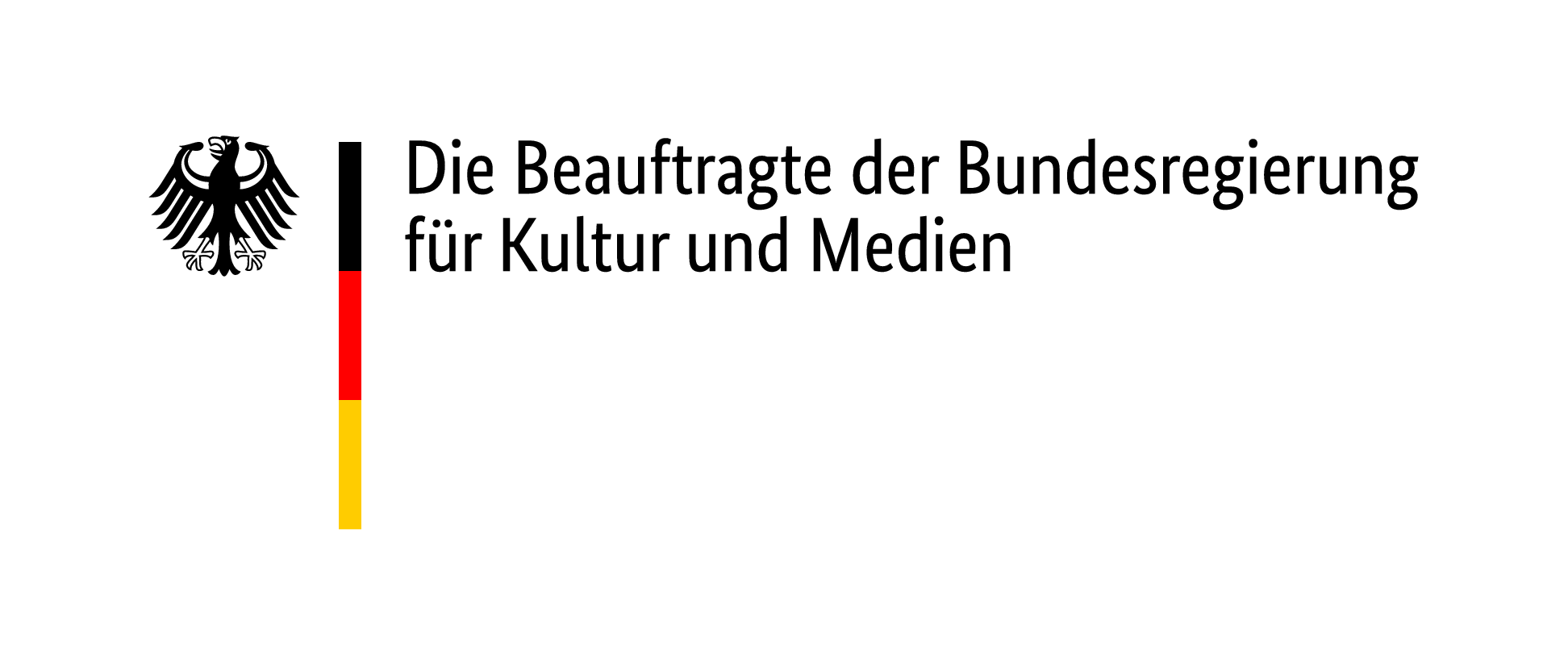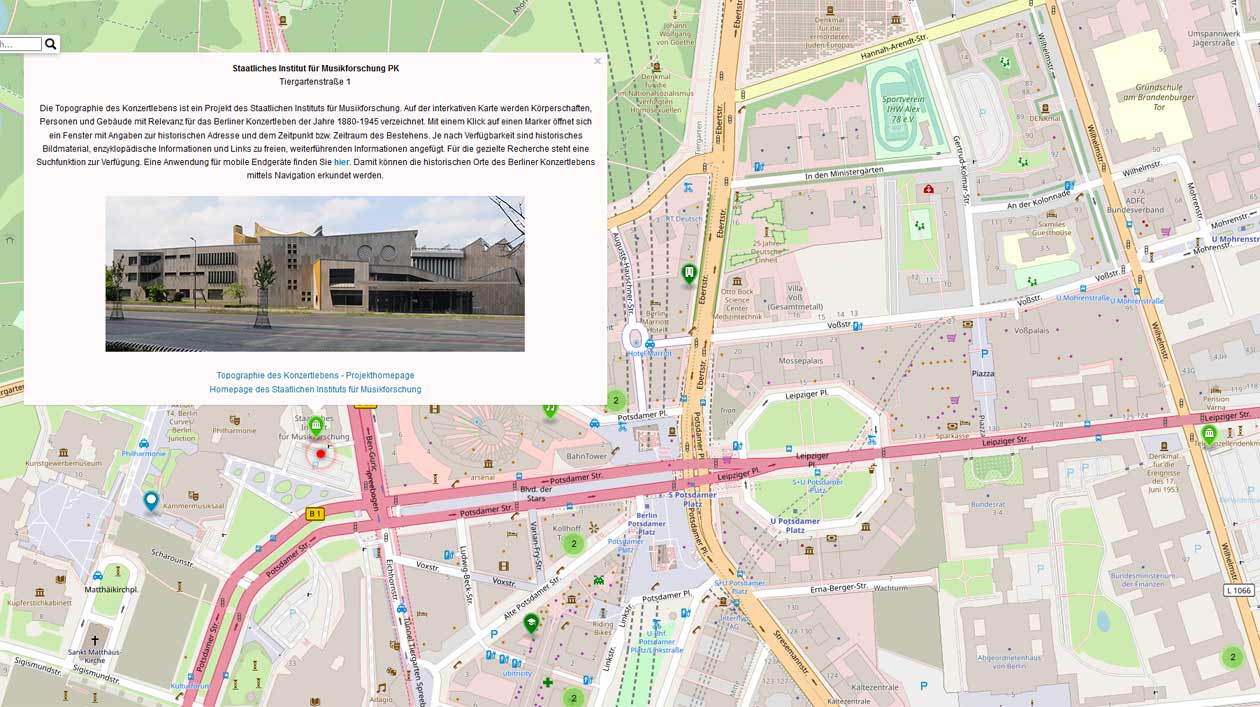Bereichsnavigation
Topography of Berlin Concert Life
1880–1945
The Topography of Berlin Concert Life 1880–1945 is an interactive map marking 250 historical geographical places, including the locations of ministries, schools, music publishers, instrument makers, concert halls and residences of performers and composers.
The project “Topography of Berlin Concert Life 1880–1945” put together a web-based map of Berlin concert life for the period 1880–1945. It was during this time, following the building of the first public concert halls in Berlin (Konzertsaal im Königlichen Nationaltheater in 1803 and Singakademie in 1826) that public concerts were professionalized and became an established part of the city’s cultural life. The interactive map marks approximately 250 historical places that were part of Berlin’s concert life from 1880 to 1945. These include the locations of ministries, schools and concert halls, the businesses of music publishers and musical instrument makers, and residences of performers and composers. Each geographical point is assigned observational data in the form of an address and the date or period of time at which the referent existed. Historical photos and concert programs give an impression of Berlin’s lively concert life from the nineteenth century until approximately the mid-twentieth century. Links to other publicly accessible sources of information allow the user to investigate Berlin’s concert life in greater depth, but the map’s intuitive design also encourages and rewards casual browsing. The larger goal of the project is to help document an area of local music history that has so far been explored only sporadically.
The topography is based on data that was gathered during the Archive of Concert Life project. In the course of that project, concert programs from Berlin during the period 1880 to 1945 were digitized and entered into a database, and for every program, the names of the venue, participating institutions and persons, and performed works were recorded. All of the entities in the database are referenced using standard data formats. In addition to facilitating the unambiguous identification of persons, institutions and buildings, this makes it possible to provide links to relevant information from external sources and ensures that the data can be used by others.
The map was made using a variety of free, open-source applications. Leaflet is a JavaScript library for mobile-friendly Internet-based map applications. It is used to create interactive markers on a defined section of a map. The map data and the coordinates of the Topography of Concert Life are based on OpenStreetMap and data from HistoMapBerlin. HistoMapBerlin makes georeferenced historical maps of Berlin available for free.
Notes on use
Periods following the year numbers (for example, “1901.” or “1897.-1914.”) mean that the actual starting point or end point of the time period in question cannot be conclusively verified based on the available sources. The information provided is observed data for the given location and time.
Berlin changed a great deal during the period of time under consideration here. In particular, the destruction caused by the Second World War had a large impact on the city’s topography. Many buildings no longer exist. For example, Schellingstraße 9, which used to be the location of the Gesellschaft der Musikfreunde (Society of Friends of Music), is now part of Piano Lake. In some cases, the coordinates of the historical addresses have been determined using historical, georeferenced maps. For historical reasons, the maps are based on the Soldner coordinate system. For the map application, it was necessary to convert these coordinates to the World Geodetic System 1984, which is more widely used internationally. As a result, these coordinates may sometimes diverge slightly from the actual geographical point. The coordinates were converted using the Map Explorer tool.
Data and tools
In the course of the project, the historical addresses and coordinates of approximately 255 persons and organizations that existed in Berlin between 1880 and 1945 were identified along with the associated GND identifiers (GND-IDs). Furthermore, for each GND-ID, the project supplies permanent links from free bibliographic and biographical reference systems. This data is available at zenodo and is governed by the Creative Commons Attribution 4.0 license.
JavaScript libraries
Software
Data sources
Coordinates
Adresses
Images
Linked sources of information
Literature
- Die Erweiterungsbauten der Philharmonie, Bernburgerstrasse 22a u. 23, und Köthenerstrasse 32. (1899). In: Deutsche Bauzeitung 33 (42), S. 265–269.
- Harmonium-Saal. (nach 1910). Berlin: Carl Simon.
- Personalstand und Adressenverzeichnis der Königlichen Akademie der Künste zu Berlin und der mit ihr verbundenen Lehrinstitute. Nach dem Stande vom 1. April 1912 (1912). Berlin: Mittler.
- Illustrierter Künstler-Almanach. Saison 1919–20 (1919). Berlin: Almanach-Verlagsanstalt.
- Jahrbuch der deutschen Musikorganisation1931 (1931). Unter Mitarbeit von Franz W. Beidler und Ellen A. Beidler. Berlin-Schöneberg: Hesse.
- Berlin als Musikstadt. Die Jahre 1910–1960 (1962). Freiburg i. Br, Bern, München: Fono-Verl.-Ges; Francke (Zugänge, 2).
- Borchard, Beatrix (2005): Stimme und Geige: Amalie und Joseph Joachim. Biographie und Interpretationsgeschichte. Wien: Böhlau (Wiener Veröffentlichungen zur Musikgeschichte, 5).
- Bosse, Fritz (1934): Musik für Dich. Ratgeber für Musikfreunde und Rundfunkhörer. Berlin: Scherl.
- Brand, Bettina; Helmig, Martina; Kaiser, Barbara u. a. (Hg.) (1987): Komponistinnen in Berlin. Berlin: Musikfrauen e. V.
- Dahlhaus, Carl (Hg.) (1980): Studien zur Musikgeschichte Berlins im frühen 19. Jahrhundert. Regensburg: Bosse (Studien zur Musikgeschichte des 19. Jahrhunderts, 56).
- Eberle, Gottfried (1991): 200 Jahre Sing-Akademie zu Berlin: "ein Kunstverein für die heilige Musik". Berlin: Nicolai.
- Kestenberg, Leo (1930): Musikorganisation. Aus dem Vorwort zum "Jahrbuch der deutschen Musikorganisation". In: Die Musik 23 (7), S. 481–487.
- Klatte, Wilhelm; Misch, Ludwig: Das Sternsche Konservatorium der Musik zu Berlin. 1850–1925: Festschrift zum 75jährigen Jubiläum.
- Leichtentritt, Hugo (1931): Das Konservatorium der Musik Klindworth-Scharwenka Berlin.
- Mitlehner, Christine; Baak, Ulrike (2000): Berlin für Musikfreunde. Service, Geschichte, Adressen. Berlin: Parthas-Verlag.
- Müller, Sven Oliver (2014): Das Publikum macht die Musik. Musikleben in Berlin, London und Wien im 19. Jahrhundert. Univ., Habil.-Schr. Bielefeld, 2013. Göttingen: Vandenhoeck & Ruprecht (V & R Academic).
- Rathert, Wolfgang; Schenk, Dietmar (Hg.) (1999): Pianisten in Berlin. Klavierspiel und Klavierausbildung seit dem 19. Jahrhundert. Hochschule der Künste Berlin; European Piano Forum. Berlin: Hochschule der Künste (HdK-Archiv, Bd. 3).
- Reichhardt, Hans J.; Müller, Gerd; Preuss, Sabine; Pett, Klaus-Dieter (1988): ...bei Kroll 1844 bis 1957. Etablissement, Ausstellungen, Theater, Konzerte, Oper, Reichstag, Gartenlokal ; eine Ausstellung des Landesarchivs Berlin, 14. Juni bis 31. Oktober 1988. Berlin: Transit (Ausstellungskataloge des Landesarchivs Berlin, 8).
- Riethmüller, Albrecht (Hg.) (2004): Busoni in Berlin. Facetten eines kosmopolitischen Komponisten. Internationale Tagung. Wiesbaden: Steiner (Musikwissenschaft).
- Ritter, Wilhelm (Hg.) (4.1934): Künstler-Almanach. Lexikon für Bühne, Konzert, Film und Funk. Berlin-Dahlem: Ritter.
- Salmen, Walter (1988): Das Konzert. Eine Kulturgeschichte. München: Beck.
- Schenk, Dietmar (2004): Die Hochschule für Musik zu Berlin. Preußens Konservatorium zwischen romantischem Klassizismus und Neuer Musik, 1869 –1932/ 33. Stuttgart: Steiner (Pallas Athene, 8).
- Schrader, Bärbel; Schebera, Jürgen (1987): Kunstmetropole Berlin 1918–1933. Die Kunststadt in der Novemberrevolution ; die "goldenen" Zwanziger ; die Kunststadt in der Krise. 1. Aufl. Berlin: Aufbau-Verl. (Dokumente und Selbstzeugnisse).
- Schünemann, Georg (1930): Das Jahrbuch der deutschen Musikorganisation. In: Die Musik 23 (9), S. 660–664.
- Schwab, Heinrich Wilhelm; Besseler, Heinrich; Schneider, Max; Bachmann, Werner (1971): Konzert. Öffentliche Musikdarbietung vom 17. bis 19. Jahrhundert. Leipzig: Deutscher Verlag für Musik (Musikgeschichte in Bildern, Musik der Neuzeit, 2).
- Siebenhaar, Klaus; Damm, Steffen (Hg.) (1998): Kulturhandbuch Berlin. Geschichte & Gegenwart von A–Z. Institut für Kultur- und Medienmanagement der Hochschule für Musik "Hanns Eisler". Berlin: FAB-Verlag.
- Verbandstag des Deutschen Musiker-Verbandes (1924): Protokoll der Verhandlungen des zweiten Verbandstages des Deutschen Musiker-Verbandes vom 16. bis einschließlich 20. Juni 1924 in Berlin. Berlin: Deutscher Musiker-Verband.
- Wahl, Horst (1986): Odeon, die Geschichte einer Schallplatten-Firma. Düsseldorf: Hansfried Sieben.
- Weissmann, Adolf (1911): Berlin als Musikstadt. Geschichte der Oper und des Konzerts von 1740 bis 1911. Berlin: Schuster & Loeffler.
Link to the interactive map
Selection of projects with related objectives
Legend of the icons
![]() Administrative institution
Administrative institution
![]() Performance venue
Performance venue
![]() Training institution
Training institution
![]() Music industry
Music industry
![]() Residence
Residence
Project information
Project team
Anja Fischer M.A. (Library staff), Sabrina Radatz B.A. (Library staff), René Wallor M.A. (Research assistant, project management)
Project duration
February 2016–August 2016
Funding

The project was funded by the Federal Government Commissioner for Culture and the Media.


